


The TRACE images may be used without restrictions
in publications of any kind. We
appreciate an acknowledgement indicating that
the Transition Region and Coronal Explorer, TRACE,
is a mission of the Stanford-Lockheed Institute for Space
Research, and part of the NASA Small Explorer program. More information on
TRACE and other TRACE images can be found
here.

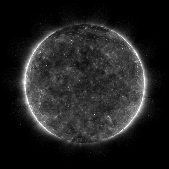 |
This mosaic image of the solar corona was obtained by TRACE on 2009/08/12 in the first hour after midnight, using its 171Å channel. The Sun is
covered by small, so-called ephemeral, bipolar magnetic regions from pole to pole, with only a faint corona glowing above it. Over the polar regions, we find the substantial coronal holes, characteristic of the sunspot minimum state. At the edge of the Sun, we see the bright ring caused by the simple fact that as we look above the edge, we see glowing plasma both in front and behind the Sun, doubling the brightness compared to just within the edge; above the edge, the intensity drops rapidly as we look at ever more tenuous plasma bound to the Sun by its gravity.
The full 5120x5120 pixel image can be found
here.
 |
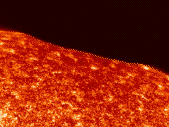 |
TRACE observed the Moon crossing in front of the Sun around the time
that the solar eclipse of 2009/07/22 was observed on Earth. This
1600Å image shows the
lunar edge just crossing the Sun's edge, at 00:33:22 UT; the movement of
TRACE in orbit around the Sun speeds up the movement of the lunar edge
relative to the Sun even more than when seen from Earth, so that there
is some blurring even in this 0.9-second exposure; nevertheless, lunar mountains
are easily seen on this image and a few following it; this
(QT) movie shows
the limb crossing from 00:29 UT through 00:36 UT.
 |
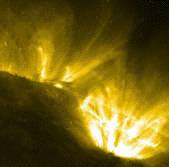 |
The Sun remained in a minimum state for a long time, but
on 2009/05/08 TRACE observed two new-cycle regions rotating over the
limb onto the visible disk. This
movie in 171Å
is a short sequence that shows these two regions (rotated by 90 degrees
clockwise) and the cusp-shaped eruption and filament activation
around 17 UT.
 |
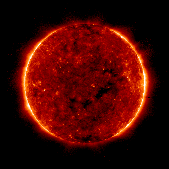 |
The big picture VIAnother very quiet day on the Sun: TRACE made this full-disk mosaic of the solar corona on 2009/05/05 using its 171Å filter (most sensitive to emission from plasma around one million Kelvin). The solar disk shows a multitude of 'small' ephemeral active regions (small for the Sun, but still typically some 10,000 km in size), and some dark coronal holes both near the equator and over both the north and south polar regions. There is a much larger 5440x5440 pixel version of this image which shows the TRACE image at full resolution.Other 'big-picture' full-disk mosaics in the TRACEpod collection
can be found here:
1,
2,
3,
4, and
5.
|
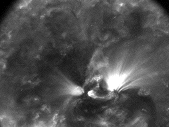 |
On 2009/03/31, TRACE was observing a rather small and inactive Active
Region in its 171Å channel. The 'quiet Sun' around it was - as
always, despite the name - very active, with a variety of phenomena.
One of these is shown in this
(17MB QT) movie.
This movie is a cutout of the full field of view, directly north of
the active region. At the very northern edge of the images, a
set of dark structures is seen moving back and forth like seaweeds in
the waves. This is a very small version of a quiet-Sun filament,
in which relatively cool matter is suspended above the solar surface,
absorbing the EUV emission from behind it, and thus showing up as a
dark structure. Why it take this shape remains under investigation.
A much larger example of a proper quiet-Sun filament is shown
here.
Courtesy of Steve Saar (SAO).
 |
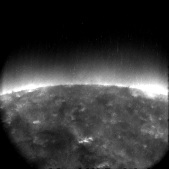 |
This 1-h
(QT) movie (rotated by
90 degrees clockwise), made by TRACE on 2009/03/17 07-08 UT, in
its 171Å passband (2x2 summed pixels), shows lots of activity
in what we call 'quiet Sun': there is a fibril (small filament)
eruption in the lower left corner, and two others just after than
over the limb (left and right). The eruption in the lower left is
even associated with a distant 'flare ribbon' below it (i.e., towards the
west, away from the limb). Courtesy of Paolo Grigis (SAO).
 |
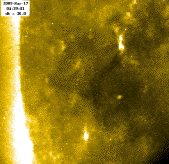 |
With the Sun in an unusually long sunspot minimum, there are no active
regions on the disk. But that does not mean that nothing is happening:
this (15MB QT) movie,
taken by TRACE in its 171Å channel (on 2009/03/16 06:17 UT to
2009/03/17 10:15 UT) shows a region of otherwise 'quiet Sun' (2x2 summed)
in which the emergence of an ephemeral region destabilizes the coronal
field configuration around 2009/03/17 04:22 UT, which causes a large-scale
wave that propagates most clearly towards the east (left) in this image.
This phenomenon of a 'coronal wave' has been seen in association
with large flares and/or coronal mass ejections from active regions,
but clearly can also happen in the surroundings of the much smaller
ephemeral regions.
 |
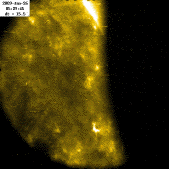 |
On 2009/0126 TRACE observed the Moon transiting the solar disk
in a series of 171Å images. The image to
the left is a snapshot taken at 05:29:45 UT that shows the limb of the Moon
partly across the limb of the Sun. The
movie shows
the rapid motion of the Moon in a sequence of images taken 15.5s apart.
Note how, once enough of the Moon covers the solar limb, the satellite
loses lock on the Sun and begins to drift towards the right; you can
just see this begin to happen before the Moon obscures the TRACE field
of view, and it is very pronounced after the Sun becomes visible again.
 |
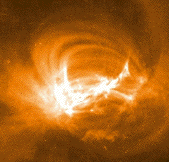 |
With the Sun still essentially in cycle minimum, sunspots are rare.
TRACE observed the first of 2009 after a 30-day absence of spots on Jan. 10.
This QuickTime movie (1.8MB) shows
the evolution of a small active region observed in the TRACE
1700Å channel, from 10-Jan. 00 UT to 12-Jan. 10 UT. The region
is small, and produced only two weak B flares on its first day in the
photosphere - the 171Å image on the left was taken on 2009/01/10
at 01:21:42 UT at a time in between these flares. Image/movie courtesy
of Aki Takeda (MSU).
 |
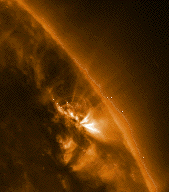 |
New-cycle Active Region 11008 rotates near the limb in this image taken on
November 16, 2008, at 09:12:23 UT by TRACE in its 171Å passband.
Active region fans are commonly
seen on the edges of the arcade and are thought to be larger, less
dense overlying loops that are only partially outlined. The fans seen
here are probably part of the smaller loop system, perpendicular to
the AR core. Some of the AR loops within the arcade appear to be
reconnecting with fan loops, creating a small jet and demonstrating
that even a small AR can have a very complex structure.
Courtesy of Samaiyah Farid (SAO).
 |
|
| Home | Mission | Instrument | Team | Operations | Results | Images | Movies | Education | Site Info. | |